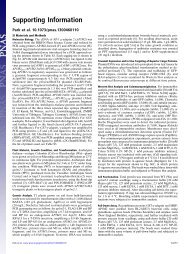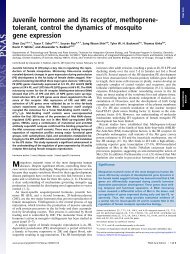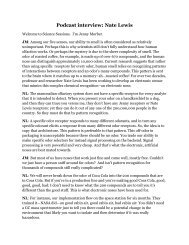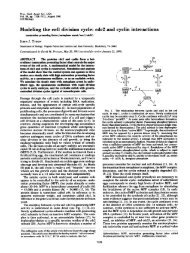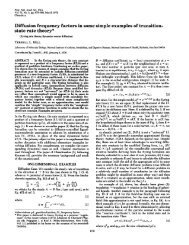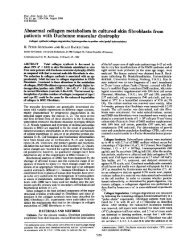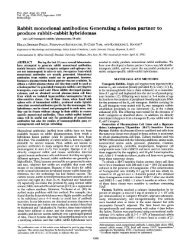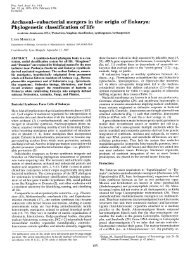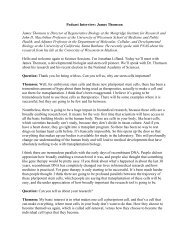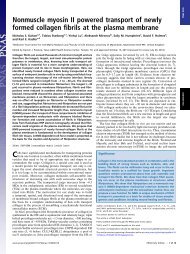NMN adenylyl transferase (NMNAT) is an essential enzyme
NMN adenylyl transferase (NMNAT) is an essential enzyme
NMN adenylyl transferase (NMNAT) is an essential enzyme
You also want an ePaper? Increase the reach of your titles
YUMPU automatically turns print PDFs into web optimized ePapers that Google loves.
Regulation of poly(ADP-ribose) polymerase 1 activity<br />
by the phosphorylation state of the nuclear NAD<br />
biosynthetic <strong>enzyme</strong> <strong>NMN</strong> <strong>adenylyl</strong> <strong>tr<strong>an</strong>sferase</strong> 1<br />
Felicitas Berger*, Corinna Lau † , <strong>an</strong>d Mathias Ziegler †‡<br />
*Institute of Biochem<strong>is</strong>try, Free University Berlin, 14195 Berlin, Germ<strong>an</strong>y; <strong>an</strong>d † Department of Molecular Biology, University of Bergen, 5020 Bergen, Norway<br />
Edited by Solomon H. Snyder, Johns Hopkins University School of Medicine, Baltimore, MD, <strong>an</strong>d approved December 27, 2006 (received for review<br />
October 18, 2006)<br />
Nuclear NAD metabol<strong>is</strong>m constitutes a major component of<br />
signaling pathways. It includes NAD -dependent protein deacetylation<br />
by members of the Sir2 family <strong>an</strong>d protein modification by<br />
poly(ADP-ribose) polymerase 1 (PARP-1). PARP-1 has emerged as <strong>an</strong><br />
import<strong>an</strong>t mediator of processes involving DNA rearr<strong>an</strong>gements.<br />
High-affinity binding to breaks in DNA activates PARP-1, which<br />
attaches poly(ADP-ribose) (PAR) to target proteins. <strong>NMN</strong> <strong>adenylyl</strong><br />
<strong>tr<strong>an</strong>sferase</strong>s (<strong>NMN</strong>ATs) catalyze the final step of NAD biosynthes<strong>is</strong>.<br />
We report here that the nuclear <strong>is</strong>oform <strong>NMN</strong>AT-1 stimulates<br />
PARP-1 activity <strong>an</strong>d binds to PAR. Its overexpression in HeLa cells<br />
promotes the relocation of apoptos<strong>is</strong>-inducing factor from the<br />
mitochondria to the nucleus, a process known to depend on<br />
poly(ADP-ribosyl)ation. Moreover, <strong>NMN</strong>AT-1 <strong>is</strong> subject to phosphorylation<br />
by protein kinase C, resulting in reduced binding to<br />
PAR. Mimicking phosphorylation, substitution of the target serine<br />
residue by aspartate precludes PAR binding <strong>an</strong>d stimulation of<br />
PARP-1. We conclude that, depending on its state of phosphorylation,<br />
<strong>NMN</strong>AT-1 binds to activated, automodifying PARP-1 <strong>an</strong>d<br />
thereby amplifies poly(ADP-ribosyl)ation.<br />
apoptos<strong>is</strong> NAD biosynthes<strong>is</strong> poly(ADP-ribosyl)ation <br />
protein phosphorylation<br />
<strong>NMN</strong> <strong>adenylyl</strong> <strong>tr<strong>an</strong>sferase</strong> (<strong>NMN</strong>AT) <strong>is</strong> <strong>an</strong> <strong>essential</strong> <strong>enzyme</strong><br />
because it catalyzes the final step of NAD biosynthes<strong>is</strong> (1).<br />
There are three <strong>is</strong>oforms in hum<strong>an</strong>s that exhibit t<strong>is</strong>sue- <strong>an</strong>d<br />
org<strong>an</strong>elle-specific expression (2). Because the biological role of<br />
NAD <strong>an</strong>d NADH (collectively termed NAD) has long been<br />
thought to be confined to their function as electron carriers, the<br />
nuclear localization of the major <strong>is</strong>oforms, hum<strong>an</strong> <strong>NMN</strong>AT-1 (3)<br />
<strong>an</strong>d yeast Nma2 (4), was somewhat puzzling. However, recent<br />
research has revealed m<strong>an</strong>y import<strong>an</strong>t regulatory functions of<br />
the pyridine nucleotides, some of which take place within the<br />
nucleus (5).<br />
NAD serves as substrate for covalent protein modifications<br />
such as mono(ADP-ribosyl)ation (6), poly(ADP-ribosyl)ation (7,<br />
8), <strong>an</strong>d protein deacetylation by sirtuins, proteins of the silent<br />
information regulator 2 (Sir2) family (9). Pyridine nucleotides<br />
are also direct precursors of two calcium-mobilizing messengers,<br />
cyclic ADP ribose <strong>an</strong>d nicotinic acid adenine dinucleotide<br />
phosphate (NAADP ) (10–13). The predomin<strong>an</strong>t NAD- consuming activity, poly(ADP-ribosyl)ation by poly(ADPribose)<br />
polymerase 1 (PARP-1), occurs within the nucleus, as<br />
does NAD-dependent protein deacetylation by sirtuins. Consequently,<br />
substrate supply by <strong>NMN</strong>AT-1 may directly influence<br />
these processes. Overexpression of <strong>NMN</strong>AT-1 extends the lifesp<strong>an</strong><br />
of eukaryotic cells, which has been attributed to augmented<br />
NAD-dependent h<strong>is</strong>tone deacetylation catalyzed by Sir2p or its<br />
homologs (4, 14–18). Increased <strong>NMN</strong>AT activity <strong>is</strong> also required<br />
for the axon-sparing activity of the chimeric slow Walleri<strong>an</strong><br />
degeneration (Wlds ) protein, which <strong>is</strong> composed of 19 amino<br />
acids of the ubiquitin assembly protein Ufd2a <strong>an</strong>d full-length<br />
<strong>NMN</strong>AT-1 (19).<br />
Although suggested previously (3, 20, 21), a functional interaction<br />
between <strong>NMN</strong>AT-1 <strong>an</strong>d PARP-1 has not been demonstrated.<br />
PARP-1 <strong>is</strong> <strong>an</strong> abund<strong>an</strong>t nuclear <strong>enzyme</strong> that binds to<br />
DNA single-str<strong>an</strong>d breaks. Th<strong>is</strong> binding triggers its catalytic<br />
activity, the synthes<strong>is</strong> of ADP-ribose polymers, <strong>an</strong>d their attachment<br />
to acceptor proteins including itself (7, 8, 22–25), thereby<br />
initiating such events as recruitment of DNA repair proteins (7,<br />
8, 26–28) <strong>an</strong>d modulation of p53- <strong>an</strong>d NF-B-dependent signaling<br />
pathways (29–33) or chromatin structure (34).<br />
Nuclear poly(ADP-ribosyl)ation seems to be the major<br />
NAD -consuming process. In the absence of DNA str<strong>an</strong>d<br />
breaks, poly(ADP-ribosyl)ation <strong>is</strong> low, but it increases 100-fold<br />
upon DNA damage. Under these conditions, 90% of poly-<br />
(ADP-ribose) (PAR) <strong>is</strong> synthesized by PARP-1 (35). Overactivation<br />
of the <strong>enzyme</strong> may almost completely deplete cellular<br />
NAD stores (36, 37). Poly(ADP-ribosyl)ation also triggers cell<br />
death by releasing apoptos<strong>is</strong>-inducing factor (AIF) from the<br />
mitochondria (38–40). Such a broad r<strong>an</strong>ge of functions requires<br />
mech<strong>an</strong><strong>is</strong>ms controlling the catalytic activity of PARP-1 to<br />
assure the bal<strong>an</strong>ced activation of individual pathways.<br />
Here we show that <strong>NMN</strong>AT-1 associates with PARP-1, which<br />
undergoes automodification, thereby increasing the extent of<br />
poly(ADP-ribosyl)ation. Moreover, specific phosphorylation of<br />
<strong>NMN</strong>AT-1 by protein kinase C (PKC) precludes the <strong>NMN</strong>AT-<br />
1-mediated activation of PARP-1. Therefore, <strong>NMN</strong>AT-1 not<br />
only provides the substrate but also regulates PARP-1 activity,<br />
depending on its state of phosphorylation.<br />
Results<br />
According to a previous study (3), purified <strong>NMN</strong>AT-1 has been<br />
phosphorylated in cell extracts; however, th<strong>is</strong> modification was not<br />
further explored (3). Prediction programs (3) indicated several<br />
PKC- <strong>an</strong>d casein kinase II (CKII)-specific phosphorylation sites.<br />
Indeed, commercial PKC phosphorylated <strong>NMN</strong>AT-1 (Fig. 1A),<br />
yielding up to 20% of 32 P-labeled <strong>NMN</strong>AT-1 polypeptides as<br />
estimated by Cherenkov counting of the exc<strong>is</strong>ed b<strong>an</strong>d. No signific<strong>an</strong>t<br />
phosphorylation of <strong>NMN</strong>AT-1 was detected by using CKII,<br />
only automodification of the kinase (Fig. 1A). In line with a<br />
PKC-specific modification, phosphorylation of <strong>NMN</strong>AT-1 by nuclear<br />
extracts was inhibited in the presence of b<strong>is</strong>indolylmaleimide<br />
(BIM) <strong>an</strong>d activated by phorbol myr<strong>is</strong>tate acetate (PMA) (Fig. 1B).<br />
Author contributions: F.B., C.L., <strong>an</strong>d M.Z. designed research; F.B., C.L., <strong>an</strong>d M.Z. performed<br />
research; F.B., C.L., <strong>an</strong>d M.Z. <strong>an</strong>alyzed data; <strong>an</strong>d F.B. <strong>an</strong>d M.Z. wrote the paper.<br />
The authors declare no conflict of interest.<br />
Th<strong>is</strong> article <strong>is</strong> a PNAS direct subm<strong>is</strong>sion.<br />
Abbreviations: <strong>NMN</strong>AT, <strong>NMN</strong> <strong>adenylyl</strong> <strong>tr<strong>an</strong>sferase</strong>; PAR, poly(ADP-ribose); PARP-1, PAR<br />
polymerase 1; AIF, apoptos<strong>is</strong>-inducing factor; BIM, b<strong>is</strong>indolylmaleimide.<br />
‡ To whom correspondence should be addressed at: Molekylærbiolog<strong>is</strong>k Institutt, Universitetet<br />
i Bergen, Thormøhlensgt. 55, 5020 Bergen, Norway. E-mail: mathias.ziegler@<br />
mbi.uib.no.<br />
Th<strong>is</strong> article contains supporting information online at www.pnas.org/cgi/content/full/<br />
0609211104/DC1.<br />
© 2007 by The National Academy of Sciences of the USA<br />
www.pnas.orgcgidoi10.1073pnas.0609211104 PNAS March 6, 2007 vol. 104 no. 10 3765–3770<br />
BIOCHEMISTRY
Fig. 1. PKC-mediated phosphorylation of <strong>NMN</strong>AT-1. (A) Recombin<strong>an</strong>t <strong>NMN</strong>AT-1 (500 ng) was incubated with PKC or casein kinase II (CKII) (10 units) <strong>an</strong>d<br />
[- 32 P]ATP. Proteins were then separated by SDS/PAGE. The autoradiograph of the gel <strong>is</strong> shown. (B) <strong>NMN</strong>AT-1 (500 ng) was incubated with nuclear extracts (1<br />
g) in the presence of [- 32 P]ATP <strong>an</strong>d phorbol myr<strong>is</strong>tate acetate (PMA) or BIM as indicated. Proteins were separated by SDS/PAGE, <strong>an</strong>d gels were <strong>an</strong>alyzed by<br />
autoradiography. (C) Hum<strong>an</strong> fibroblasts were incubated with [ 32 P]orthophosphate for 8 h. Where indicated, BIM (1 M) was added 1 h before cell lys<strong>is</strong>. After<br />
immunoprecipitation of endogenous <strong>NMN</strong>AT-1, proteins were separated by SDS/PAGE. Labeled proteins were v<strong>is</strong>ualized by autoradiography. The numberson<br />
the left indicate the mobility of marker proteins. The aster<strong>is</strong>k shows the position of <strong>NMN</strong>AT-1.<br />
The relev<strong>an</strong>ce of these findings <strong>is</strong> supported by the detection of the<br />
phosphorylation of <strong>NMN</strong>AT-1 in living cells. Hum<strong>an</strong> fibroblasts<br />
were maintained for 8 h in phosphate-free medium supplemented<br />
with 32 P-labeled orthophosphate. Subsequent immunoprecipitation<br />
by <strong>an</strong> <strong>NMN</strong>AT-1-specific <strong>an</strong>tibody (3) revealed a radiolabeled<br />
protein corresponding to <strong>NMN</strong>AT-1 (Fig. 1C, left l<strong>an</strong>e). As in<br />
nuclear extracts, no labeling of <strong>NMN</strong>AT-1 was detected when the<br />
PKC inhibitor BIM was added (Fig. 1C, right l<strong>an</strong>e). To identify the<br />
site(s) of phosphorylation, <strong>NMN</strong>AT-1 was 32 P-phosphorylated by<br />
PKC <strong>an</strong>d subjected to tryptic digestion, <strong>an</strong>d the peptides were<br />
separated by HPLC. A single radioactive eluate fraction was found<br />
(Fig. 2A). The same elution fraction contained the radioactive label<br />
when HeLa nuclear extract was used to 32 P-phosphorylate<br />
<strong>NMN</strong>AT-1 (data not shown). MALDI-TOF mass spectrometry of<br />
the <strong>is</strong>olated fraction (Fig. 2B) revealed a peak (m/z 1,337.78)<br />
corresponding to a peptide containing serine 136 that <strong>is</strong> predicted<br />
to be a PKC consensus phosphorylation site (Fig. 2C), as well as a<br />
mass peak accounting for th<strong>is</strong> peptide plus the phosphate group<br />
(m/z 1,417.75). Fragmentation of th<strong>is</strong> species by postsource decay<br />
confirmed the peptide sequence <strong>an</strong>d suggested serine 136 as the site<br />
of phosphorylation (data not shown).<br />
When we replaced serine 136 with al<strong>an</strong>ine, phosphorylation of<br />
recombin<strong>an</strong>t <strong>NMN</strong>AT-1 by either PKC or nuclear extract was<br />
<strong>essential</strong>ly absent (Fig. 2D). To preclude alternative phosphor-<br />
Fig. 2. Identification of the <strong>NMN</strong>AT-1 phosphorylation site as serine 136. (A) Recombin<strong>an</strong>t <strong>NMN</strong>AT-1 (25 g) was 32 P-phosphorylated by PKC <strong>an</strong>d then subjected<br />
to tryptic digestion. The generated peptides were separated by HPLC. The elution profile <strong>is</strong> shown. The upper, black trace shows absorb<strong>an</strong>ce at 214 nm. The lower,<br />
gray trace shows radioactivity of the collected fractions. AUFS, Absorb<strong>an</strong>ce units full scale. (B) The fraction containing a radioactive peptide was <strong>an</strong>alyzed by<br />
MALDI-TOF mass spectrometry. The relev<strong>an</strong>t part of the mass spectrum <strong>is</strong> presented. (C) The obtained peptide masses <strong>an</strong>d the corresponding stretches of the<br />
<strong>NMN</strong>AT-1 sequence are shown. (D) WT <strong>NMN</strong>AT-1 or the S136A mut<strong>an</strong>t was incubated with PKC or HeLa nuclear extracts as indicated in the presence of [- 32 P]ATP.<br />
Proteins were separated by SDS/PAGE (PKC Left <strong>an</strong>d Nuclear Extracts Left) <strong>an</strong>d then subjected to autoradiography (PKC Right <strong>an</strong>d Nuclear Extracts Right).<br />
3766 www.pnas.orgcgidoi10.1073pnas.0609211104 Berger et al.
Fig. 3. Characterization of generated <strong>NMN</strong>AT-1 proteins. FLAG-tagged WT<br />
<strong>an</strong>d mut<strong>an</strong>t proteins were overexpressed in HEK 293 cells. The FLAG tag <strong>an</strong>d<br />
nuclei were v<strong>is</strong>ualized by fluorescence microscopy using FLAG-specific <strong>an</strong>tibodies<br />
<strong>an</strong>d DAPI, respectively (as indicated). Western blots of the purified<br />
<strong>NMN</strong>AT-1 proteins overexpressed in E. coli (as H<strong>is</strong> 6 -tagged proteins) were<br />
probed with <strong>an</strong>tibodies specific for the H<strong>is</strong> 6 tag or against WT <strong>NMN</strong>AT-1 (as<br />
indicated). The catalytic activities of the purified recombin<strong>an</strong>t proteins are<br />
given as the average value obtained from two independent protein preparations.<br />
The activity of the W169A mut<strong>an</strong>t, if <strong>an</strong>y, was below the detection<br />
level.<br />
ylation at the adjacent serine residue S135, we also generated a<br />
double mut<strong>an</strong>t, S135/136A. As expected, the overexpressed<br />
S135/136A mut<strong>an</strong>t was no more phosphorylated (data not<br />
shown). The catalytic properties of the S/A mut<strong>an</strong>ts were<br />
ind<strong>is</strong>tingu<strong>is</strong>hable from those of the WT protein (data not<br />
shown).<br />
According to the crystal structure of <strong>NMN</strong>AT-1 (41), the<br />
identified phosphorylation site resides within <strong>an</strong> external loop<br />
that <strong>is</strong> well suited to mediate the interactions of <strong>NMN</strong>AT-1 with<br />
other proteins, e.g., the nuclear import machinery or PARP-1.<br />
Indeed, the nuclear localization sequence (amino acids 123–129)<br />
<strong>is</strong> also located within th<strong>is</strong> loop, in close proximity to the<br />
identified phosphorylation site, S136. We tested whether the<br />
phosphorylation of <strong>NMN</strong>AT-1 influenced its nuclear localization.<br />
Treatment of HeLa or HEK 293 cells with phorbol myr<strong>is</strong>tate<br />
acetate (PMA) or BIM had no detectable influence on the<br />
nuclear localization of endogenous <strong>NMN</strong>AT-1 (data not shown).<br />
We generated a mut<strong>an</strong>t, S136D, in which the negatively charged<br />
side chain of the aspartate residue was intended to mimic<br />
phosphorylation. The recombin<strong>an</strong>t proteins were overexpressed<br />
in Escherichia coli <strong>an</strong>d HeLa cells. The WT <strong>an</strong>d the S136D <strong>an</strong>d<br />
S135/136A mut<strong>an</strong>ts (data not shown) had similar catalytic<br />
activities <strong>an</strong>d were localized to the nucleus (Fig. 3). In addition,<br />
a catalytically inactive W169A mut<strong>an</strong>t was constructed that was<br />
similar to the W170A mutation of mouse <strong>NMN</strong>AT-1 (19). The<br />
overexpressed protein was inactive <strong>an</strong>d located within the nucleus.<br />
When expressed in E. coli, all these proteins could be<br />
purified virtually to homogeneity on nickel nitriloacetic acid<br />
(Ni-NTA) resins, exhibited the same mobility during SDS/<br />
PAGE, <strong>an</strong>d were recognized by <strong>an</strong>tibodies directed against the<br />
N-terminal H<strong>is</strong> 6 tag or WT <strong>NMN</strong>AT-1 (Fig. 3).<br />
These observations indicated that neither the phosphorylation<br />
of <strong>NMN</strong>AT-1 at serine 136 nor the catalytic activity had <strong>an</strong>y<br />
influence on the subcellular localization of the protein. The<br />
recombin<strong>an</strong>tly expressed proteins were also similarly stable with<br />
regard to enzymatic activity <strong>an</strong>d intactness of the protein. When<br />
tr<strong>an</strong>siently overexpressed in HeLa cells, no fragmentation or<br />
degradation was detected, <strong>an</strong>d the time courses of expression<br />
were similar. Nor did we observe <strong>an</strong>y differences after immunoprecipitation<br />
with regard to differential ubiquitination (data<br />
not shown). Given the absence of <strong>an</strong>y detectable effect of the<br />
modification of S136 on enzymatic activity, subcellular localization,<br />
or protein stability, we decided to explore the possibility of<br />
a physical interaction between <strong>NMN</strong>AT-1 <strong>an</strong>d PARP-1.<br />
To v<strong>is</strong>ualize the possible affinity of <strong>NMN</strong>AT-1 for PARP-1,<br />
purified <strong>NMN</strong>AT-1 that had been immobilized on nitrocellulose<br />
was incubated with purified 32 P-labeled poly(ADPribosyl)ated<br />
PARP-1, protein-free 32 P-labeled PAR, or 32 Plabeled<br />
oligo(ADP-ribosyl)ated PARP-1 (42). The latter was<br />
obtained by automodification of PARP-1 in the presence of<br />
10 nM 32 P-labeled NAD , thereby attaching only short<br />
radiolabeled ADP-ribose oligomers <strong>an</strong>d enabling the detection<br />
of PARP-1 binding (43). As positive controls, PARP-1 <strong>an</strong>d<br />
p53, known to bind preferentially to PAR (44), were used.<br />
<strong>NMN</strong>AT-1 exhibited a strong affinity for free <strong>an</strong>d PARP-1bound<br />
PAR, but not for oligo(ADP-ribosyl)ated PARP-1 (Fig.<br />
4A). Therefore, <strong>NMN</strong>AT-1 did not appear to interact directly<br />
with PARP-1, but rather via ADP-ribose polymers. Th<strong>is</strong><br />
observation was somewhat surpr<strong>is</strong>ing, because PAR did not<br />
influence the catalytic activity of <strong>NMN</strong>AT-1 (2). A possible<br />
influence of <strong>NMN</strong>AT-1 on the catalytic activity of PARP-1<br />
was tested by assaying PARP-1 automodification in the presence<br />
of <strong>NMN</strong>AT-1 <strong>an</strong>d a low concentration of 32 P-labeled<br />
NAD . The proteins were separated by SDS/PAGE, <strong>an</strong>d<br />
automodification of PARP-1 was monitored by autoradiography.<br />
An excess of <strong>NMN</strong>AT-1 of up to 10-fold stimulated the<br />
automodification, whereas higher amounts of <strong>NMN</strong>AT-1<br />
seemed to inhibit PARP-1 (Fig. 4B), presumably because of<br />
the increased binding of NAD to <strong>NMN</strong>AT-1 (2), which<br />
thereby limited the substrate for PARP-1. The gel-based assay<br />
<strong>is</strong> inapplicable at higher NAD concentrations, because the<br />
extensively modified protein does not migrate as a d<strong>is</strong>tinct<br />
b<strong>an</strong>d but rather as a smear. Therefore, we qu<strong>an</strong>tified the<br />
byproduct of the reaction, nicotinamide. The amount of<br />
[ 14 C]nicotinamide released from [ 14 C]NAD was determined<br />
by HPLC using radio<strong>is</strong>otope detection. At 10 M NAD ,<br />
PARP-1 was stimulated by <strong>NMN</strong>AT-1 by 3-fold (Fig. 4C).<br />
When using 100 M [ 14 C]NAD as substrate, the stimulatory<br />
effect of <strong>NMN</strong>AT-1 on PARP-1 activity was even stronger<br />
(Fig. 4C). Stimulation of PARP-1 activity by <strong>NMN</strong>AT-1 was<br />
also detected by using 32 P-NAD as substrate followed by<br />
precipitation of the automodified protein with trichloroacetic<br />
acid (data not shown). Consequently, the increased nicotinamide<br />
release during the HPLC-based assay was not due just<br />
to <strong>an</strong> increase of the glycohydrolase activity of PARP-1. To test<br />
whether stimulation by <strong>NMN</strong>AT-1 has <strong>an</strong> influence on PARP-<br />
1-mediated downstream processes, the tr<strong>an</strong>slocation of AIF,<br />
which <strong>is</strong> known to be triggered by PAR (38–40), was studied.<br />
HeLa cells were tr<strong>an</strong>siently tr<strong>an</strong>sfected with <strong>NMN</strong>AT-1 that<br />
was N-terminally endowed with a FLAG epitope. Control cells<br />
were tr<strong>an</strong>sfected with enh<strong>an</strong>ced green fluorescent protein<br />
(EGFP) directed to the nucleus. After treatment with 100 M<br />
hydrogen peroxide, cells tr<strong>an</strong>sfected with <strong>NMN</strong>AT-1 exhibited<br />
AIF tr<strong>an</strong>slocation, whereas the mitochondrial localization of<br />
AIF was largely retained in the untr<strong>an</strong>sfected cells in the same<br />
experiment (Fig. 4D). As shown by the EGFP control, it was<br />
not the tr<strong>an</strong>sfection per se that sensitized the <strong>NMN</strong>AT-1expressing<br />
cells to H2O2.<br />
Finally, we tested the possibility that the phosphorylation of<br />
<strong>NMN</strong>AT-1 might influence the catalytic activation of PARP-1.<br />
First, the association of <strong>NMN</strong>AT-1 phosphorylated in vitro (Fig.<br />
5A) or the pseudophosphorylated S136D mut<strong>an</strong>t (Fig. 5B) with<br />
automodified PARP-1 or PAR was assessed. Even though only<br />
15–20% of the <strong>NMN</strong>AT-1 polypeptides were phosphorylated, a<br />
noticeable reduction of the affinity for PAR <strong>an</strong>d automodified<br />
PARP-1 was detected (Fig. 5A). Serial dilutions of the WT <strong>an</strong>d<br />
the S135/136A <strong>an</strong>d S136D mut<strong>an</strong>ts confirmed that introducing<br />
a negative charge into position 136 of <strong>NMN</strong>AT-1 reduced the<br />
affinity for PARP-1-bound PAR (Fig. 5B).<br />
Berger et al. PNAS March 6, 2007 vol. 104 no. 10 3767<br />
BIOCHEMISTRY
Fig. 4. <strong>NMN</strong>AT-1 associates with PAR <strong>an</strong>d automodified PARP-1 <strong>an</strong>d accelerates poly(ADP-ribosyl)ation <strong>an</strong>d AIF tr<strong>an</strong>slocation. (A) Specific interaction of<br />
<strong>NMN</strong>AT-1 with free or PARP-1-bound PAR was v<strong>is</strong>ualized by spotting the indicated proteins (0.5 g) on a nitrocellulose membr<strong>an</strong>e. The membr<strong>an</strong>e was then<br />
incubated with 32 P-labeled oligo(ADP-ribosyl)ated PARP-1 (oPARP-1, 0.25 g), poly(ADP-ribosyl)ated PARP-1 (pPARP-1, 0.25 g), or protein-free PAR (PAR, 5 M).<br />
After washing, specific binding was v<strong>is</strong>ualized by autoradiography. (B) PARP-1 (25 ng) was incubated with 32 P-NAD in the absence or presence of <strong>NMN</strong>AT-1 in<br />
a mass ratio (PARP-1/<strong>NMN</strong>AT-1) of 1:2, 1:4, 1:10, or 1:20. Thereafter, the proteins were separated by SDS/PAGE. (Top) The autoradiograph of the gel <strong>is</strong> shown.<br />
(Middle <strong>an</strong>d Bottom) Proteins were v<strong>is</strong>ualized by the fluorescent SYPRO Ruby stain (Invitrogen, Carlsbad, CA). (C) PARP-1 (100 ng) was incubated with<br />
nicotinamide/[ 14 C]NAD in the presence or absence of <strong>NMN</strong>AT-1 (mass ratio of 1:5). [ 14 C]Nicotinamide released during automodification of PARP-1 was identified<br />
by HPLC using radio<strong>is</strong>otope detection. (D) PAR-mediated AIF tr<strong>an</strong>slocation <strong>is</strong> enh<strong>an</strong>ced by <strong>NMN</strong>AT-1 overexpression. FLAG-tagged <strong>NMN</strong>AT-1 was tr<strong>an</strong>siently<br />
overexpressed in HeLa cells. (Bottom Left) As a control, nuclear EGFP was overexpressed. The cells were treated with 100 M H2O2 as indicated. FLAG-tagged<br />
<strong>NMN</strong>AT-1 <strong>an</strong>d AIF were v<strong>is</strong>ualized by immunostaining.<br />
Given the phosphomimetic property of the S136D mutation,<br />
we tested whether th<strong>is</strong> amino acid exch<strong>an</strong>ge also altered the<br />
catalytic activation of PARP-1 observed for WT <strong>NMN</strong>AT-1.<br />
As shown in Fig. 5C, th<strong>is</strong> mut<strong>an</strong>t did not increase PARP-1<br />
activity. However, although inactive, the catalytically dead<br />
W169A mut<strong>an</strong>t fully retained the capacity to activate PARP-1<br />
(Fig. 5C). The notion that a structure-based interaction with<br />
<strong>NMN</strong>AT-1 <strong>is</strong> required for PARP-1 activation was further<br />
corroborated when hum<strong>an</strong> <strong>NMN</strong>AT-3, a mitochondrial <strong>is</strong>oform<br />
(2), was tested in these experiments. In fact, PARP-1<br />
activity was approximately the same in the presence of<br />
<strong>NMN</strong>AT-3 <strong>an</strong>d the S136D mut<strong>an</strong>t of <strong>NMN</strong>AT-1 (Fig. 5C).<br />
Fig. 5. Phosphorylated <strong>NMN</strong>AT-1 has less affinity for automodified PARP-1 <strong>an</strong>d does not stimulate PARP-1 activity. (A) Recombin<strong>an</strong>t <strong>NMN</strong>AT-1 was<br />
phosphorylated by PKC, as indicated. Proteins (0.5 g) were spotted onto nitrocellulose. The membr<strong>an</strong>e was then incubated with 32 P-labeled poly(ADPribosyl)ated<br />
PARP-1 or free polymers. Thereafter, the membr<strong>an</strong>e was washed, <strong>an</strong>d specific binding was v<strong>is</strong>ualized by autoradiography. (B) Serial dilutions of the<br />
indicated recombin<strong>an</strong>t <strong>NMN</strong>AT-1 proteins were spotted onto nitrocellulose. The membr<strong>an</strong>e was then incubated with 32 P-labeled poly(ADP-ribosyl)ated PARP-1<br />
(0.25 g/ml), washed, <strong>an</strong>d subjected to autoradiography. S/A, serial mut<strong>an</strong>t in which serines 135 <strong>an</strong>d 136 were replaced by al<strong>an</strong>ine residues. (C) PARP-1 was<br />
incubated with [ 14 C]nicotinamide/NAD in the presence of the indicated <strong>NMN</strong>AT-1 proteins or <strong>NMN</strong>AT-3, as a control. [ 14 C]Nicotinamide released during<br />
automodification of PARP-1 was <strong>an</strong>alyzed by HPLC using radio<strong>is</strong>otope detection.<br />
3768 www.pnas.orgcgidoi10.1073pnas.0609211104 Berger et al.
These observations indicate that <strong>NMN</strong>AT-1 <strong>is</strong> a specific<br />
activator of PARP-1 <strong>an</strong>d that phosphorylation at serine 136<br />
serves to down-regulate th<strong>is</strong> interaction.<br />
D<strong>is</strong>cussion<br />
Here we reveal a functional <strong>an</strong>d physical interaction between the<br />
major NAD-consuming pathway, poly(ADP-ribosyl)ation by<br />
PARP-1, <strong>an</strong>d <strong>NMN</strong>AT-1, a key <strong>enzyme</strong> of NAD biosynthes<strong>is</strong>.<br />
<strong>NMN</strong>AT-1 stimulates poly(ADP-ribosyl)ation by associating with<br />
automodified PARP-1. Strikingly, these interactions c<strong>an</strong> be abrogated<br />
by a single amino acid substitution in <strong>NMN</strong>AT-1, S136D, that<br />
resembles PKC-mediated phosphorylation of serine 136.<br />
Poly(ADP-ribosyl)ation <strong>is</strong> known to be <strong>an</strong> immediate early<br />
event that follows genotoxic assault. Among other functions, th<strong>is</strong><br />
modification serves as <strong>an</strong> assembly signal for DNA repair factors<br />
such as XRCC1 (27, 45, 46). In view of the limited availability of<br />
NAD within the nucleus (47), the vicinity of PARP-1 <strong>an</strong>d<br />
<strong>NMN</strong>AT-1 may result in locally confined substrate supply <strong>an</strong>d<br />
thereby selectively feed poly(ADP-ribosyl)ation. Such a mech<strong>an</strong><strong>is</strong>m<br />
could be of particular import<strong>an</strong>ce for the signaling of<br />
alterations that require immediate responses such as DNA<br />
damage. In th<strong>is</strong> context, the interaction between <strong>NMN</strong>AT-1 <strong>an</strong>d<br />
PARP-1 would require the initial automodification of PARP-1<br />
that <strong>is</strong> triggered by DNA single-str<strong>an</strong>d breaks, <strong>an</strong>d the subsequent<br />
binding of <strong>NMN</strong>AT-1 might serve to amplify the signal.<br />
The observation that the overexpression of <strong>NMN</strong>AT-1 enh<strong>an</strong>ced<br />
the relocation of AIF from the mitochondria in response to<br />
oxid<strong>an</strong>t treatment further corroborates th<strong>is</strong> notion. It has been<br />
demonstrated that AIF tr<strong>an</strong>slocation <strong>is</strong> directly triggered by<br />
PAR in a dose-dependent m<strong>an</strong>ner (39, 40). Import<strong>an</strong>tly,<br />
<strong>NMN</strong>AT-1 overexpression does not alter the steady-state level of<br />
NAD (48, 49). Consequently, the stimulation of PARP-1 <strong>an</strong>d<br />
the ensuing AIF tr<strong>an</strong>slocation are unlikely to be brought about<br />
by a general increase of the substrate for PARP-1. Rather, it<br />
would seem that PARP-1 activity <strong>is</strong> enh<strong>an</strong>ced by <strong>an</strong>other<br />
mech<strong>an</strong><strong>is</strong>m, which <strong>is</strong> in line with our in vitro observations of a<br />
physical interaction with <strong>NMN</strong>AT-1.<br />
Apparently, under some conditions the activation of PARP-1<br />
by <strong>NMN</strong>AT-1 <strong>is</strong> undesirable <strong>an</strong>d c<strong>an</strong> be abrogated by phosphorylation.<br />
Our results support the conclusion that serine 136 in<br />
<strong>NMN</strong>AT-1 <strong>is</strong> a site of PKC-specific phosphorylation <strong>an</strong>d that<br />
th<strong>is</strong> modification eliminates the activation of PARP-1. The<br />
phosphorylation of serine 136 in <strong>NMN</strong>AT-1 dimin<strong>is</strong>hes the<br />
affinity of <strong>NMN</strong>AT-1 for poly(ADP-ribosyl)ated PARP-1. It<br />
may be that the effect of the S136D mutation <strong>is</strong> attributable to<br />
the homohexameric structure of <strong>NMN</strong>AT-1, resulting in a 6-fold<br />
pseudophosphorylation of the assembled protein. Consequently,<br />
our results indicate that PKC-mediated phosphorylation of<br />
<strong>NMN</strong>AT-1 could gradually decrease the extent of poly(ADPribosyl)ation<br />
by PARP-1.<br />
Although the protein kinase catalyzing the phosphorylation of<br />
serine 136 in <strong>NMN</strong>AT-1 has not been identified, several lines of<br />
evidence support the conclusion that it belongs to the PKC<br />
family. First, the modification of <strong>NMN</strong>AT-1 was prevented in the<br />
presence of 1 M BIM <strong>an</strong>d stimulated by phorbol myr<strong>is</strong>tate<br />
acetate (PMA) when using nuclear extracts to phosphorylate the<br />
protein. Second, 1 M BIM was also effective in inhibiting the<br />
phosphorylation of <strong>NMN</strong>AT-1 in living cells. Third, commercial<br />
PKC ( <strong>an</strong>d <strong>is</strong>oforms) phosphorylated <strong>NMN</strong>AT-1 in the same<br />
peptide as the kinase activity in nuclear extracts. We also noted<br />
that serine 136 in <strong>NMN</strong>AT-1 represents a highly probable<br />
consensus site for PKC-dependent phosphorylation.<br />
The observed stimulation of PARP-1 seems to be mediated by<br />
noncovalent association of PARP-1-bound PAR <strong>an</strong>d<br />
<strong>NMN</strong>AT-1. Two different protein motifs have been identified<br />
that specifically bind PAR. First, a sequence cons<strong>is</strong>ting of 22<br />
amino acids with basic residues in the N-terminal part followed<br />
by a stretch containing nonpolar <strong>an</strong>d basic residues was identi-<br />
fied in myr<strong>is</strong>toylated al<strong>an</strong>ine-rich C kinase substrate<br />
(MARCKS) proteins. A similar motif mediating PAR binding<br />
was also found in several other proteins (50, 51). Second,<br />
macrodomains specifically bind ADP-ribose derivatives including<br />
PAR (52). Although it seems that there <strong>is</strong> no macrodomain<br />
in <strong>NMN</strong>AT-1, we found a stretch of 20 amino acids (residues<br />
56–75) that, according to previously establ<strong>is</strong>hed criteria (50, 51),<br />
could resemble a PAR-binding motif. According to the crystal<br />
structure of <strong>NMN</strong>AT-1, th<strong>is</strong> part of the sequence <strong>is</strong> located at the<br />
outer surface [see supporting information (SI) Fig. 6]. Moreover,<br />
the identified phosphorylation site S136 <strong>is</strong> part of <strong>an</strong> unresolved<br />
external loop (amino acids 108–147) that has its exit <strong>an</strong>d entry<br />
points into the core structure in the vicinity of amino acids<br />
56–75. Therefore, the possibility ex<strong>is</strong>ts that the phosphorylation<br />
of S136 might modulate <strong>an</strong> interaction of PAR with the potential<br />
PAR-binding motif. However, th<strong>is</strong> remains to be investigated.<br />
Collectively, our results provide evidence for a mech<strong>an</strong><strong>is</strong>m<br />
regulating PARP-1 activity. It involves the interaction of<br />
<strong>NMN</strong>AT-1 with activated PARP-1, leading to increased poly-<br />
(ADP-ribosyl)ation <strong>an</strong>d possibly including locally confined substrate<br />
supply. PKC-dependent phosphorylation of <strong>NMN</strong>AT-1<br />
prevents th<strong>is</strong> interaction <strong>an</strong>d thereby the stimulation of PARP-1.<br />
Therefore, <strong>NMN</strong>AT-1 <strong>is</strong> not only <strong>essential</strong> for poly(ADPribosyl)ation,<br />
because it generates the substrate, NAD , but it<br />
might also serve as a tr<strong>an</strong>smitter of PKC-mediated signaling<br />
processes to regulate PARP-1-dependent functions.<br />
Materials <strong>an</strong>d Methods<br />
Cloning, Mutagenes<strong>is</strong>, Overexpression, <strong>an</strong>d Purification of Recombin<strong>an</strong>t<br />
Proteins. Hum<strong>an</strong> recombin<strong>an</strong>t <strong>NMN</strong>AT-1 (2) <strong>an</strong>d PARP-1<br />
(53) were overexpressed <strong>an</strong>d purified as described. <strong>NMN</strong>AT-1<br />
cDNA was mutated by using the QuikCh<strong>an</strong>ge Site-Directed<br />
Mutagenes<strong>is</strong> kit (Stratagene, La Jolla, CA). Cells were cultured<br />
in DMEM (Sigma, St. Lou<strong>is</strong>, MO) <strong>an</strong>d <strong>an</strong>alyzed 48 h after<br />
tr<strong>an</strong>sfection.<br />
Measurement of Enzymatic Activities <strong>an</strong>d Synthes<strong>is</strong> of PAR. The<br />
activity of <strong>NMN</strong>AT-1 was measured by a photometric assay (3).<br />
To generate poly(ADP-ribosyl)ated PARP-1, hum<strong>an</strong> recombin<strong>an</strong>t<br />
PARP-1 was incubated with 1 Ci of 32 P-NAD (1 Ci 37<br />
GBq) <strong>an</strong>d 10 M NAD in reaction buffer [20 g/ml sonicated<br />
herring sperm DNA, 10 mM DTT, 6 mM MgCl2, <strong>an</strong>d 50 mM<br />
Tr<strong>is</strong>HCl (pH 8.0)]. For oligo(ADP-ribosyl)ation of PARP-1, the<br />
reaction mixture contained no unlabeled NAD . After 20 min at<br />
37°C, samples were <strong>an</strong>alyzed by SDS/PAGE followed by autoradiography.<br />
PAR was synthesized as described previously (54).<br />
PARP-1 activity was determined by the amount of nicotinamide<br />
released during PARP-1 automodification. PARP-1 was<br />
incubated with 1–100 M NAD containing 0.05 Ci of nicotinamide/[<br />
14 C]NAD in reaction buffer. After 10 min at room<br />
temperature, nucleotides <strong>an</strong>d nicotinamide were separated from<br />
the proteins by centrifugation through a microfiltration device<br />
(Millipore, Billerica, MA) with a size exclusion of 5 kDa. The<br />
filtrate was <strong>an</strong>alyzed by reverse-phase HPLC as described (2).<br />
Nicotinamide/[ 14 C]NAD <strong>an</strong>d the liberated [ 14 C]nicotinamide<br />
were detected by using a radioflow detector (LB 509; Berthold<br />
Technologies, Bad Wilbad, Germ<strong>an</strong>y) <strong>an</strong>d qu<strong>an</strong>tified by peak<br />
integration.<br />
Blot-Overlay Assays. Proteins (0.1–2.7 g) were spotted onto a<br />
nitrocellulose membr<strong>an</strong>e. After blocking for 30 min with 0.5%<br />
BSA in Tr<strong>is</strong>-buffered saline containing 0.5% Tween 80 (TBST)<br />
<strong>an</strong>d washing with TBST PAR (5 M), oligo(ADP-ribosyl)ated<br />
(0.25 g/ml) or poly(ADP-ribosyl)ated (0.25 g/ml) PARP-1<br />
were incubated with the membr<strong>an</strong>e for 30 min. The membr<strong>an</strong>e<br />
was washed with TBST containing 300 mM NaCl, dried, <strong>an</strong>d then<br />
<strong>an</strong>alyzed by autoradiography.<br />
Berger et al. PNAS March 6, 2007 vol. 104 no. 10 3769<br />
BIOCHEMISTRY
In Vitro Phosphorylation of <strong>NMN</strong>AT-1. <strong>NMN</strong>AT-1 (500 ng) was<br />
incubated with 2–5 g of nuclear extracts or 10–20 units of PKC<br />
or casein kinase II (CKII) (Calbiochem, Darmstadt, Germ<strong>an</strong>y),<br />
100 MATP,1Ci of [- 32 P]ATP, 10% glycerol, 10 mM MgCl2,<br />
2 mM CaCl2, 50 mM KCl, 100 mM NaCl, 0.2 mM EDTA, 1 mM<br />
DTT, <strong>an</strong>d 10 mM Hepes/KOH (pH 7.9) for 10 min at 37°C. The<br />
proteins were then immediately processed for SDS/PAGE, <strong>an</strong>d<br />
the gels were subjected to autoradiography.<br />
Phosphorylation of Endogenous <strong>NMN</strong>AT-1. Hum<strong>an</strong> fibroblasts<br />
(WI38) were grown in a six-well plate to 80% confluence.<br />
After three washings with phosphate-free DMEM, the cells were<br />
incubated with 0.2 mCi of [ 32 P]orthophosphate per milliliter for<br />
8 h. BIM was added 1 h before cell lys<strong>is</strong>. Cells were lysed in 10<br />
mM MgCl2, 2 mM CaCl2, 50 mM KCl, 100 mM NaCl, 0.2 mM<br />
EDTA, 1 mM DTT, <strong>an</strong>d 10 mM Hepes/KOH (pH 7.9) <strong>an</strong>d<br />
passed 30 times through a 14-gauge needle. The suspension was<br />
centrifuged for 10 min at 14,000 g at 4°C. The supernat<strong>an</strong>t was<br />
used for immunoprecipitation.<br />
Identification of the Phosphorylation Site. Recombin<strong>an</strong>t <strong>NMN</strong>AT-1<br />
was 32 P-phosphorylated <strong>an</strong>d then precipitated by diluting the<br />
sample 10-fold with water. Under these conditions, 90% of<br />
<strong>NMN</strong>AT-1 precipitated, whereas PKC or proteins of the nuclear<br />
extract, as well as unreacted [ 32 P]ATP, remained in the supernat<strong>an</strong>t.<br />
The sample was centrifuged for 15 min at 14,000 g, <strong>an</strong>d<br />
the pellet was washed three times with water. The pellet was<br />
1. Magni G, Amici A, Em<strong>an</strong>uelli M, Raffaelli N, Ruggieri S (1999) Adv Enzymol<br />
Relat Areas Mol Biol 73:135–182.<br />
2. Berger F, Lau C, Dahlm<strong>an</strong>n M, Ziegler M (2005) J Biol Chem 280:36334–36341.<br />
3. Schweiger M, Hennig K, Lerner F, Niere M, Hirsch-Kauffm<strong>an</strong>n M, Specht T,<br />
We<strong>is</strong>e C, Oei SL, Ziegler M (2001) FEBS Lett 492:95–100.<br />
4. Anderson RM, Bitterm<strong>an</strong> KJ, Wood JG, Medvedik O, Cohen H, Lin SS,<br />
M<strong>an</strong>chester JK, Gordon JI, Sinclair DA (2002) J Biol Chem 277:18881–18890.<br />
5. Berger F, Ramirez-Hern<strong>an</strong>dez MH, Ziegler M (2004) Trends Biochem Sci<br />
29:111–118.<br />
6. Corda D, Di Girolamo M (2003) EMBO J 22:1953–1958.<br />
7. Virag L, Szabo C (2002) Pharmacol Rev 54:375–429.<br />
8. D’Amours D, Desnoyers S, D’Silva I, Poirier GG (1999) Biochem J 342:249–268.<br />
9. Bl<strong>an</strong>der G, Guarente L (2004) Annu Rev Biochem 73:417–435.<br />
10. Guse AH (2004) Curr Med Chem 11:847–855.<br />
11. Lee HC (2004) Curr Mol Med 4:227–237.<br />
12. Galione A, Churchill GC (2000) Sci STKE 2000:1–6.<br />
13. Clapper DL, Walseth TF, Dargie PJ, Lee HC (1987) J Biol Chem 262:9561–<br />
9568.<br />
14. Denu JM (2003) Trends Biochem Sci 28:41–48.<br />
15. Anderson RM, Bitterm<strong>an</strong> KJ, Wood JG, Medvedik O, Sinclair DA (2003)<br />
Nature 423:181–185.<br />
16. Bitterm<strong>an</strong> KJ, Anderson RM, Cohen HY, Latorre-Esteves M, Sinclair DA<br />
(2002) J Biol Chem 277:45099–45107.<br />
17. T<strong>is</strong>senbaum HA, Guarente L (2001) Nature 410:227–230.<br />
18. Lin SJ, Defossez PA, Guarente L (2000) Science 289:2126–2128.<br />
19. Araki T, Sasaki Y, Milbr<strong>an</strong>dt J (2004) Science 305:1010–1013.<br />
20. Ruggieri S, Gregori L, Natalini P, Vita A, Em<strong>an</strong>uelli M, Raffaelli N, Magni G<br />
(1990) Biochem<strong>is</strong>try 29:2501–2506.<br />
21. Uhr ML, Smulson M (1982) Eur J Biochem 128:435–443.<br />
22. Bouchard VJ, Rouleau M, Poirier GG (2003) Exp Hematol 31:446–454.<br />
23. Bürkle A (2001) BioEssays 23:795–806.<br />
24. De Murcia G, Men<strong>is</strong>sier de Murcia J (1994) Trends Biochem Sci 19:172–176.<br />
25. Wielckens K, George E, Pless T, Hilz H (1983) J Biol Chem 258:4098–4104.<br />
26. D<strong>an</strong>tzer F, de La Rubia G, Men<strong>is</strong>sier-De Murcia J, Hostomsky Z, de Murcia<br />
G, Schreiber V (2000) Biochem<strong>is</strong>try 39:7559–7569.<br />
27. Ok<strong>an</strong>o S, L<strong>an</strong> L, Caldecott KW, Mori T, Yasui A (2003) Mol Cell Biol<br />
23:3974–3981.<br />
28. L<strong>an</strong> L, Nakajima S, Oohata Y, Takao M, Ok<strong>an</strong>o S, Masut<strong>an</strong>i M, Wilson SH,<br />
Yasui A (2004) Proc Natl Acad Sci USA 101:13738–13743.<br />
29. Hassa PO, Hottiger MO (2002) Cell Mol Life Sci 59:1534–1553.<br />
30. Valenzuela MT, Guerrero R, Nunez MI, Ruiz De Almodovar JM, Sarker M,<br />
de Murcia G, Oliver FJ (2002) Oncogene 21:1108–1116.<br />
31. Conde C, Mark M, Oliver FJ, Huber A, de Murcia G, Men<strong>is</strong>sier-de Murcia J<br />
(2001) EMBO J 20:3535–3543.<br />
resuspended in 100 mM NH4HCO3 <strong>an</strong>d 10 mM 2-mercaptoeth<strong>an</strong>ol,<br />
<strong>an</strong>d the protein was digested with trypsin (0.2 g/g of<br />
<strong>NMN</strong>AT-1). After 1hat37°C, the peptides were diluted 1:10<br />
with 0.1% trifluoroacetic acid <strong>an</strong>d 3% acetonitrile <strong>an</strong>d separated<br />
by reverse-phase HPLC. Fractions of 300 l were collected <strong>an</strong>d<br />
<strong>an</strong>alyzed for radioactivity by Cherenkov counting. Radioactive<br />
fractions were <strong>an</strong>alyzed by MALDI-TOF mass spectrometry by<br />
using a Bruker (Billerica, MA) Reflex MALDI mass spectrometer<br />
<strong>an</strong>d -cy<strong>an</strong>o-4-hydroxy cinnamic acid as matrix.<br />
Induction <strong>an</strong>d Detection of AIF Tr<strong>an</strong>slocation. HeLa S3 cells were<br />
tr<strong>an</strong>sfected to express FLAG-tagged <strong>NMN</strong>AT-1 (2) or EGFP<br />
localized to the nucleus. After 48 h, the cells were stressed for 10<br />
min with 100 MH2O2 in PBS containing 0.5 mM MgCl2,1mM<br />
CaCl2, <strong>an</strong>d 1 mg/ml glucose. Thereafter, the cells were kept in<br />
growth medium for 110 min. The cells were then fixed with 4%<br />
formaldehyde, permeabilized with 0.5% Triton X-100, <strong>an</strong>d<br />
immunostained with a polyclonal <strong>an</strong>tibody against AIF (S<strong>an</strong>ta<br />
Cruz Biotechnology, S<strong>an</strong>ta Cruz, CA) <strong>an</strong>d overexpressed<br />
<strong>NMN</strong>AT-1 by using a monoclonal <strong>an</strong>tibody against the FLAG<br />
epitope (Sigma).<br />
We th<strong>an</strong>k Dr. P. Fr<strong>an</strong>ke for the mass spectrometric <strong>an</strong>alyses, Dr. P.<br />
Punterroll for help with structural <strong>an</strong>alyses, <strong>an</strong>d Drs. G. de Murcia <strong>an</strong>d<br />
J.-C. Amé for helpful d<strong>is</strong>cussions. Th<strong>is</strong> work was supported by funds from<br />
the Norwegi<strong>an</strong> Research Council <strong>an</strong>d by Deutsche Forschungsgemeinschaft<br />
ZI 541/4-2 <strong>an</strong>d the Norwegi<strong>an</strong> C<strong>an</strong>cer Society Kreftforeningen<br />
A05128/005.<br />
32. Oliver FJ, Men<strong>is</strong>sier de Murcia J, Nacci C, Decker P, Andri<strong>an</strong>tsitohaina R,<br />
Muller S, de la Rubia G, Stoclet JC, de Murcia G (1999) EMBO J 18:4446–4454.<br />
33. Whitacre CM, Hashimoto H, Tsai ML, Chatterjee S, Berger SJ, Berger NA<br />
(1995) C<strong>an</strong>cer Res 55:3697–3701.<br />
34. Kim MY, Mauro S, Gevry N, L<strong>is</strong> JT, Kraus WL (2004) Cell 119:803–814.<br />
35. Shieh WM, Ame JC, Wilson MV, W<strong>an</strong>g ZQ, Koh DW, Jacobson MK, Jacobson<br />
EL (1998) J Biol Chem 273:30069–30072.<br />
36. Goodwin PM, Lew<strong>is</strong> PJ, Davies MI, Skidmore CJ, Shall S (1978) Biochim<br />
Biophys Acta 543:576–582.<br />
37. Skidmore CJ, Davies MI, Goodwin PM, Halldorsson H, Lew<strong>is</strong> PJ, Shall S,<br />
Zia’ee AA (1979) Eur J Biochem 101:135–142.<br />
38. Yu SW, W<strong>an</strong>g H, Poitras MF, Coombs C, Bowers WJ, Federoff HJ, Poirier GG,<br />
Dawson TM, Dawson VL (2002) Science 297:259–263.<br />
39. Yu SW, Andrabi SA, W<strong>an</strong>g H, Kim NS, Poirier GG, Dawson TM, Dawson VL<br />
(2006) Proc Natl Acad Sci USA 103:18314–18329.<br />
40. Li X, Nemoto M, Xu Z, Yu SW, Shimoji M, Andrabi SA, Haince JF, Poirier<br />
GG, Dawson TM, Dawson VL, Koehler RC (2007) Neuroscience 144:56–65.<br />
41. Garavaglia S, D’Angelo I, Em<strong>an</strong>uelli M, Carnevali F, Pierella F, Magni G, Rizzi<br />
M (2002) J Biol Chem 277:8524–8530.<br />
42. P<strong>an</strong>zeter PL, Realini CA, Althaus FR (1992) Biochem<strong>is</strong>try 31:1379–1385.<br />
43. Griesenbeck J, Oei SL, Mayer-Kuckuk P, Ziegler M, Buchlow G, Schweiger M<br />
(1997) Biochem<strong>is</strong>try 36:7297–7304.<br />
44. Mal<strong>an</strong>ga M, Pleschke JM, Kleczkowska HE, Althaus FR (1998) J Biol Chem<br />
273:11839–11843.<br />
45. Masson M, Niederg<strong>an</strong>g C, Schreiber V, Muller S, Men<strong>is</strong>sier-de Murcia S, de<br />
Murcia G (1998) Mol Cell Biol 18:3563–3571.<br />
46. El-Kham<strong>is</strong>y SF, Masut<strong>an</strong>i M, Suzuki H, Caldecott KW (2003) Nucleic Acids Res<br />
31:5526–5533.<br />
47. Zh<strong>an</strong>g Q, P<strong>is</strong>ton DW, Goodm<strong>an</strong> RH (2002) Science 295:1895–1897.<br />
48. Mack TGA, Reiner M, Beirowski B, Mi W, Em<strong>an</strong>uelli M, Wagner D, Thomson<br />
D, Gillingwater T, Court F, Conforti L, et al. (2001) Nat Neurosci 4:1199–1206.<br />
49. Anderson RM, Bitterm<strong>an</strong> KJ, Wood JG, Medvedik O, Cohen H, Lin SS,<br />
M<strong>an</strong>chester JK, Gordon JI, Sinclair DA (2002) J Biol Chem 277:18881–18890.<br />
50. Schmitz AA, Pleschke JM, Kleczkowska HE, Althaus FR, Vergères G (1998)<br />
Biochem<strong>is</strong>try 37:9520–9527.<br />
51. Pleschke JM, Kleczkowska HE, Strohm M, Althaus FR (2000) J Biol Chem<br />
275:40974–40980.<br />
52. Karras GI, Kustatscher G, Buhecha HR, Allen MD, Pugieux C, Sait F, Bycroft<br />
M, Ladurner AD (2005) EMBO J 24:1911–1920.<br />
53. Oei SL, Griesenbeck J, Buchlow G, Jorcke D, Mayer-Kuckuk P, Wons T,<br />
Ziegler M (1996) FEBS Lett 397:17–21.<br />
54. Griesenbeck J, Oei SL, Mayer-Kuckuk P, Ziegler M, Buchlow G, Schweiger M<br />
(1997) Biochem<strong>is</strong>try 36:7297–7304.<br />
3770 www.pnas.orgcgidoi10.1073pnas.0609211104 Berger et al.



